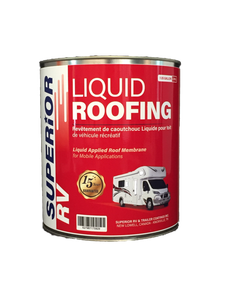 Elastomeric Commercial Roof Coatings: Types, Applications
Elastomeric Commercial Roof Coatings: Types, Applications
If you think you'll be conserving the roof decking plywood (not replacing it), then you may save yourself some clean-up difficulty by getting rid of the components first and after that peeling up the rubber! Detail of water damage on camper roofing system. More water damaged locations on Recreational Vehicle roofing decking. There was nothing really awful that made me seem like I was going to fall through, however certainly a great deal of damage and I was getting the feeling I would be replacing a great deal of the roof decking plywood.
 Waterproof Roof Coating, Elastomeric Metal Roof Coatings
Waterproof Roof Coating, Elastomeric Metal Roof Coatings
Read More Here: Tucson roofing repair companies - DCRoofingArizona.com
I went for the simplest one first, a vent cap from a kitchen sink plumbing vent pipe. Starting to scrape caulk and sealant. I utilized a stiff scraper with a chisel-like blade and simply started spying and cracking and scraping and hacking. There is no other method around this, you simply need to begin digging up until you expose the screw heads.
Unscrewing the screws in vent cap. The screws on this vent cap were hex-head metal screws so I utilized a little socket chauffeur to eliminate them. Some came out clean. Others were rusted and I had to use a vice-grip pliers to get the heads and turn them bit by bit.
I found an old wasp nest inside the vent cover. This is a sight I'll probably need to get used to, discovering the remains of animal habitation in every nook and cranny. I invest a horrible great deal of my time creating great wildlife habitat in my backyard so I don't get upset when a creature picks to set up house in my RV.
Tips For Applying Your Elastomeric Roof Coating
Thankfully no one was house in this old nest so I simply tossed it. Perhaps I'll put a screen over it when changing it. Which brings us to the next point. You must attempt not to damage these pieces (like vent covers and caps) as you're removing the old caulk and sealant just in case you require to use them once again.
(Guess I'll learn when the roof is done!) Prying up the vent cap and getting rid of the last ring of rubber roof underneath. So I pried up the remainder of the cap and scraped up the remaining rubber roofing and butyl tape and putty and 25 years of other gunk and here's how it looks tidied up.
 Roof Coating Contractor For Elastomeric Roof
Roof Coating Contractor For Elastomeric Roof
One down, 7 more components to go. Next I chose to take on the only roofing ventilation fan that my camper has. My roofing vent also had a vent cover over it. So I began scraping the gunk from those screws. Starting on the roofing vent. Hardware exposed on roof vent cap, the very roof coating cost first nut came off tidy.
 How To Apply Elastomeric Cool Roof Coatings: 3 Easy Steps
How To Apply Elastomeric Cool Roof Coatings: 3 Easy Steps
Bolt is spinning. The fasteners on this RV roofing vent cover were nuts on little bolts. The first one came off great with an extension socket kit. The 2nd one just began spinning, meaning the bolt was not fixed in place but turning in addition to the nut. Downer. A peek at the hardware holding down the roofing vent cover.
Jetcoat Cool King Reflective Acrylic Roof Coating, Waterproof
I didn't have any great way to hold the bolt in place so instead I decided to saw through the bolts with a reciprocating saw. Sawing through bolts on roofing vent cover. I used a cordless reciprocating saw with a metal-cutting blade however it was tricky to get the blade flat enough to reach the bolts so near the roof deck. Most were so old and rusted that they sheared off when I unscrewed then with a great deal of force. Loosening the brackets that held the vent cover in location. Then I scraped more caulk and roofing system sealant off the flange of the roofing system vent itself. I quickly found there were no more screws or hardware holding it down so I offered up on the scraping and went inside the Recreational Vehicle After scraping the caulk and sealant from flange of roofing vent, no more screws! Loosening the within cover plate of roofing vent fan in RV bathroom.
A couple sheared off with a great deal of force, but two would not budge. So I needed to drill out the screw heads. I selected a drill bit near the size of the shaft of the screws that I had currently pulled out and began drilling. Picking a drill bit for drilling out a screw head.
Safety glasses recommended. So I drilled out the heads, one popped off and the other I was getting annoyed with and provided it a tug before it was drilled through. Instead of popping off the screw head, the plastic just dissolved around the hot screw head. Whoops. Hope I do not need to recycle this cover.
If not, I'll require larger screw heads when re-assembling. Cover plate removed from roofing system vent. Next I discovered little corner brackets with hex-head bolts holding them in. I loosened them (all came out great the good news is) and took out the brackets and little white plastic spacers. Loosening corner brackets in roofing vent.
Proper Surface Preparation Is Essential Before Applying Roof
All corner brackets removed, ready to pull out. When the brackets were out I returned up top to pry out the the roofing system vent. Then I scraped up all the staying gunk and rubber roofing. Taking off the old roofing system vent. There are two wires going to the roofing system vent (a black hot wire and a white neutral wire) that you'll require to clip to remove the old vent.